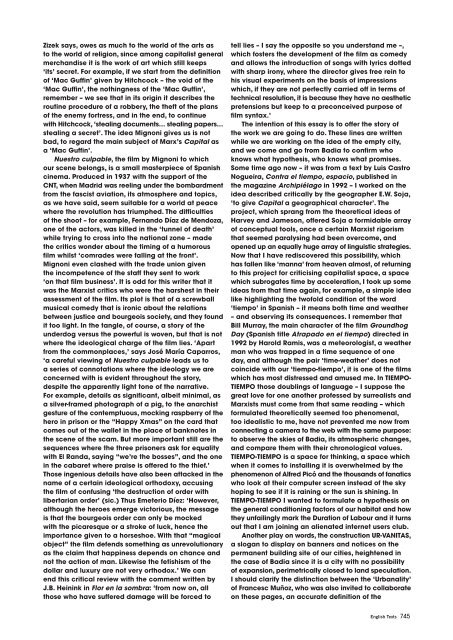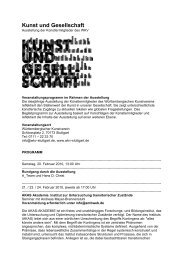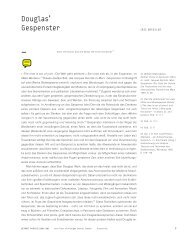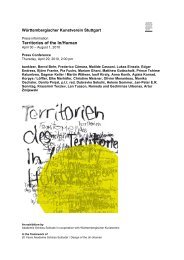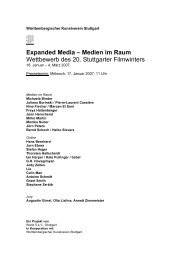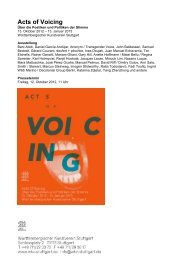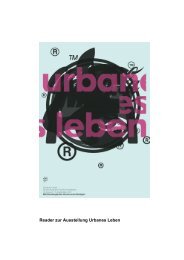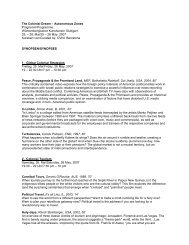English Texts
English Texts
English Texts
Create successful ePaper yourself
Turn your PDF publications into a flip-book with our unique Google optimized e-Paper software.
Zizek says, owes as much to the world of the arts as<br />
to the world of religion, since among capitalist general<br />
merchandise it is the work of art which still keeps<br />
‘its’ secret. For example, if we start from the definition<br />
of ‘Mac Guffin’ given by Hitchcock – the void of the<br />
‘Mac Guffin’, the nothingness of the ‘Mac Guffin’,<br />
remember – we see that in its origin it describes the<br />
routine procedure of a robbery, the theft of the plans<br />
of the enemy fortress, and in the end, to continue<br />
with Hitchcock, ‘stealing documents… stealing papers…<br />
stealing a secret’. The idea Mignoni gives us is not<br />
bad, to regard the main subject of Marx’s Capital as<br />
a ‘Mac Guffin’.<br />
Nuestro culpable, the film by Mignoni to which<br />
our scene belongs, is a small masterpiece of Spanish<br />
cinema. Produced in 1937 with the support of the<br />
CNT, when Madrid was reeling under the bombardment<br />
from the fascist aviation, its atmosphere and topics,<br />
as we have said, seem suitable for a world at peace<br />
where the revolution has triumphed. The difficulties<br />
of the shoot – for example, Fernando Díaz de Mendoza,<br />
one of the actors, was killed in the ‘tunnel of death’<br />
while trying to cross into the national zone – made<br />
the critics wonder about the timing of a humorous<br />
film whilst ‘comrades were falling at the front’.<br />
Mignoni even clashed with the trade union given<br />
the incompetence of the staff they sent to work<br />
‘on that film business’. It is odd for this writer that it<br />
was the Marxist critics who were the harshest in their<br />
assessment of the film. Its plot is that of a screwball<br />
musical comedy that is ironic about the relations<br />
between justice and bourgeois society, and they found<br />
it too light. In the tangle, of course, a story of the<br />
underdog versus the powerful is woven, but that is not<br />
where the ideological charge of the film lies. ‘Apart<br />
from the commonplaces,’ says José María Caparros,<br />
‘a careful viewing of Nuestro culpable leads us to<br />
a series of connotations where the ideology we are<br />
concerned with is evident throughout the story,<br />
despite the apparently light tone of the narrative.<br />
For example, details as significant, albeit minimal, as<br />
a silver-framed photograph of a pig, to the anarchist<br />
gesture of the contemptuous, mocking raspberry of the<br />
hero in prison or the “Happy Xmas” on the card that<br />
comes out of the wallet in the place of banknotes in<br />
the scene of the scam. But more important still are the<br />
sequences where the three prisoners ask for equality<br />
with El Randa, saying “we’re the bosses”, and the one<br />
in the cabaret where praise is offered to the thief.’<br />
Those ingenious details have also been attacked in the<br />
name of a certain ideological orthodoxy, accusing<br />
the film of confusing ‘the destruction of order with<br />
libertarian order’ (sic.) Thus Emeterio Díez: ‘However,<br />
although the heroes emerge victorious, the message<br />
is that the bourgeois order can only be mocked<br />
with the picaresque or a stroke of luck, hence the<br />
importance given to a horseshoe. With that “magical<br />
object” the film defends something as unrevolutionary<br />
as the claim that happiness depends on chance and<br />
not the action of man. Likewise the fetishism of the<br />
dollar and luxury are not very orthodox.’ We can<br />
end this critical review with the comment written by<br />
J.B. Heinink in Flor en la sombra: ‘from now on, all<br />
those who have suffered damage will be forced to<br />
tell lies – I say the opposite so you understand me –,<br />
which fosters the development of the film as comedy<br />
and allows the introduction of songs with lyrics dotted<br />
with sharp irony, where the director gives free rein to<br />
his visual experiments on the basis of impressions<br />
which, if they are not perfectly carried off in terms of<br />
technical resolution, it is because they have no aesthetic<br />
pretensions but keep to a preconceived purpose of<br />
film syntax.’<br />
The intention of this essay is to offer the story of<br />
the work we are going to do. These lines are written<br />
while we are working on the idea of the empty city,<br />
and we come and go from Badia to confirm who<br />
knows what hypothesis, who knows what promises.<br />
Some time ago now – it was from a text by Luis Castro<br />
Nogueira, Contra el tiempo, espacio, published in<br />
the magazine Archipiélago in 1992 – I worked on the<br />
idea described critically by the geographer E.W. Soja,<br />
‘to give Capital a geographical character’. The<br />
project, which sprang from the theoretical ideas of<br />
Harvey and Jameson, offered Soja a formidable array<br />
of conceptual tools, once a certain Marxist rigorism<br />
that seemed paralysing had been overcome, and<br />
opened up an equally huge array of linguistic strategies.<br />
Now that I have rediscovered this possibility, which<br />
has fallen like ‘manna’ from heaven almost, of returning<br />
to this project for criticising capitalist space, a space<br />
which subrogates time by acceleration, I took up some<br />
ideas from that time again, for example, a simple idea<br />
like highlighting the twofold condition of the word<br />
‘tiempo’ in Spanish – it means both time and weather<br />
– and observing its consequences. I remember that<br />
Bill Murray, the main character of the film Groundhog<br />
Day (Spanish title Atrapado en el tiempo) directed in<br />
1992 by Harold Ramis, was a meteorologist, a weather<br />
man who was trapped in a time sequence of one<br />
day, and although the pair ‘time-weather’ does not<br />
coincide with our ‘tiempo-tiempo’, it is one of the films<br />
which has most distressed and amused me. In TIEMPO-<br />
TIEMPO those doublings of language – I suppose the<br />
great love for one another professed by surrealists and<br />
Marxists must come from that same reading – which<br />
formulated theoretically seemed too phenomenal,<br />
too idealistic to me, have not prevented me now from<br />
connecting a camera to the web with the same purpose:<br />
to observe the skies of Badia, its atmospheric changes,<br />
and compare them with their chronological values.<br />
TIEMPO-TIEMPO is a space for thinking, a space which<br />
when it comes to installing it is overwhelmed by the<br />
phenomenon of Alfred Picó and the thousands of fanatics<br />
who look at their computer screen instead of the sky<br />
hoping to see if it is raining or the sun is shining. In<br />
TIEMPO-TIEMPO I wanted to formulate a hypothesis on<br />
the general conditioning factors of our habitat and how<br />
they unfailingly mark the Duration of Labour and it turns<br />
out that I am joining an alienated internet users club.<br />
Another play on words, the construction UR-VANITAS,<br />
a slogan to display on banners and notices on the<br />
permanent building site of our cities, heightened in<br />
the case of Badia since it is a city with no possibility<br />
of expansion, perimetrically closed to land speculation.<br />
I should clarify the distinction between the ‘Urbanality’<br />
of Francesc Muñoz, who was also invited to collaborate<br />
on these pages, an accurate definition of the<br />
<strong>English</strong> <strong>Texts</strong> 745


